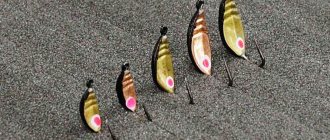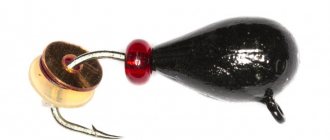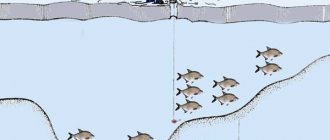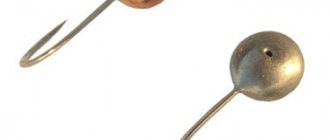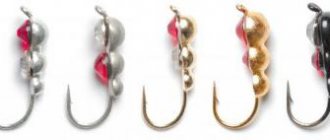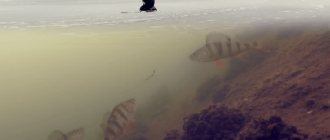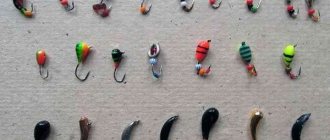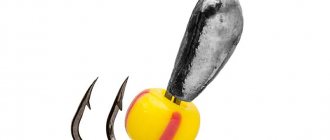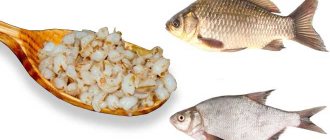For many anglers, catching roach on the first ice is a long-awaited event, the first opportunity to open a new freeze-up season and again see the trembling of the nod, feel the resistance of the fish on a thin line. With the formation of ice, any promising areas become available for fishing. And fishing for roach is accessible and possible in all regions due to the prevalence of this fish.
However, the roach, also known as sorog in the north, ram on the Don, roach on the Volga or chebak in Siberia, is not so simple. You can almost always catch small specimens at the beginning of freeze-up. But hunting for large roach, from 200 grams, requires a competent tactical approach from the fisherman.
Catching roach from ice at the beginning of winter
Immediately after the ice forms, the roach actively feeds in the coastal zone, among the grass, in the same places as in the fall. Large specimens stand deeper - under the edges, on the ruts after the holes, visiting hollows and colonies of shells.
- Search depth – 1.5-3 meters. In 2-3 weeks, when due to lack of light underwater vegetation begins to die en masse and the oxygen balance of these places changes, schools of this fish will leave such water areas and sink deeper, to depths of 3-5 meters. Therefore, fishing for roach on first ice is successful in the same places as in open water in the fall.
- Roach are active on the first ice. This fish is a fast raider. Her role is to quickly visit an area where there is something attractive, grab it in conditions of food competition and quickly step aside and calmly swallow it.
- If there is heavy fish at the point - crucian carp, bream, then the roach will not feed calmly. This fish scurries higher, trying to snatch what it can among the slow fish. Only large individuals, 300-400 grams or more, behave measuredly, moving slowly near the bottom and selectively calmly eating food items. Large roaches, like bream or carp, are able to grind small shells with their pharyngeal teeth.
Article about catching roach in winter:
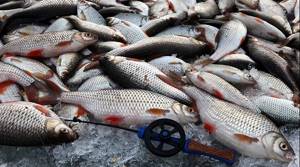
On large reservoirs and rivers, roaches already gather in large schools during the first ice, occupying their favorite places - shallow feeding tables among great depths, underwater meanders with shells, watering after holes and pools with a smooth current and algae at the bottom.
- In such places you can always find food, including in winter. Fishermen know such points and return to them every winter. Here we know for sure that the roach is here, all that remains is to find it and entice it to bite.
- On the first ice, the roach is usually active, and the angler’s goal is to find its feeding place. In the dead of winter, the absence of bites is not an indicator that there are no fish under the hole. Now the silver weasel is taking advantage of the last comfortable days to stock up on useful substances for the winter.
- Only the weather or other phenomena can affect the intensity of the bite - changes in the water level, the entry of unusual waste into the reservoir, and the like.
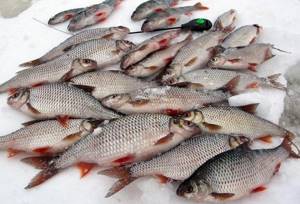
Roach prefers quiet, cloudy weather, without sudden changes in atmospheric pressure. Rainy thaws without wind or quietly falling snow, when the pressure drops slowly and evenly, are the best times for catching sorog. However, many bodies of water show that this is far from the rule. The roach can take in frosty weather, snow, and wind. The only true observation is that with sudden changes in weather, the bite usually stops.
The roach is active all winter, changing the intensity of feeding depending on external conditions. You can always catch it on the first ice by choosing the right tactics, bait and technique for working with tackle. For beginners, this fish may seem capricious, however, experienced anglers catch consistently, despite weather changes.
Catching roach in winter with a jig
Catching roach in winter with a jig is effective during the freeze-up period. On the first and last ice, you can attract active fish to the fishing area with the help of bait, but in the dead of winter you have to look for catchable places in all known promising areas. In any case, an active search for roach with jig tackle is more effective compared to stationary fishing with a winter float rod.
Roach is caught using a jig using a nodding winter fishing rod. It consists of a short rod, a simple inertial reel, onto which a sufficient amount (maximum depth of the reservoir + 5 - 10 m reserve) of fishing line with a diameter of about 0.1 mm is wound. A mount is installed for the nod, which will allow you to increase or decrease the working part of the nod. This will allow you to adjust its rigidity when fishing. You will need to change the stiffness when using jigs of different weights, which change during the fishing process. Alternatively, you can use quickly replaceable nods.
When catching roach in winter on the first ice, sometimes it is enough to drill several holes at a distance of 5–6 steps from each other in a promising fishing spot, feed them and fish them one by one, periodically adding complementary food. This way you can keep the roach in the fishing area for a long time, which ultimately will be the key to a good catch.
In the dead of winter, roach becomes passive and has to be looked for in depressions and holes in the bottom relief. In the middle of winter, roach is unlikely to catch up with a nimble bait. During this period, biting is possible when feeding a jig with an appetizing bait right under the fish’s nose.
The last ice makes it easier to find and catch roach, as they begin to become active when the ice begins to melt. At the end of winter, the bait used often works.
Where to look for roach on the first ice
In large water areas with a uniform bottom topography, a school of roach will stop where features or anomalies are present. These are local pits or tubercles, areas with irregularities and gullies. In such places, food lingers, and the sorog has something to profit from. The roach moves actively on the first ice, but does not go far from the feeding points.
In natural reservoirs there is plenty of shelter for roach.
- Hollows near the shore, flooded snags, islands of grass and algae, and vegetation edges are promising places. Small and medium-sized roaches can always be found here.
- Large individuals that live in separate small flocks need to be looked for deeper - in irrigation areas adjacent to a riverbed or a large slope, at depths of more than 3 meters.
- You need to look for roach on the first ice on the river in the same place where it was caught in the fall, and further, at medium depths.
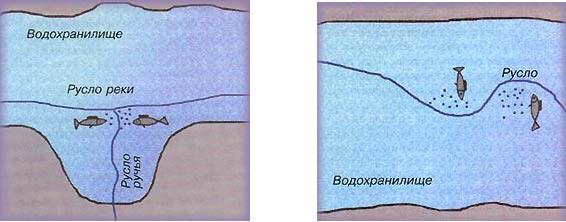
- The mouths of streams and rivers, bends, places with reverse flows, branches of bushes hanging over a deep coastal ravine - during the first ice the roach can be anywhere.
- On reservoirs, the coastal strip is usually too shallow. In such reservoirs we look further from the shore, behind the first edge.
- Promising areas for large roach on small and medium-sized reservoirs are the meanders of the old channel, ditches from inflowing tributaries and the junction with the main depression of the old stream.
- In large reservoirs, areas in front of deep dumps, rocky ridges, as well as long spits that go into the depths, always serve as feeding places for bream, silver bream and crucian carp. Large roach will also circle around with this fish.
Article about fishing on the first ice:
https://podlednik.ru/lovlya_zimoj/rybalka/po-pervomu-ldu
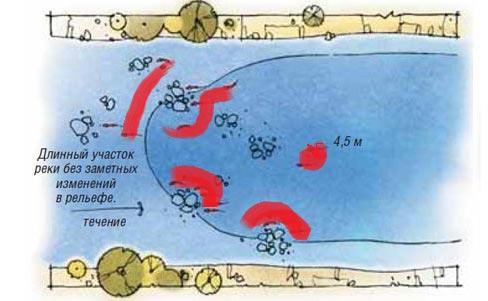
Any anomalies at the average depth along the first ice are interesting:
- Old snags in the bays, overlooking the deep dump.
- Islands of algae in calm water next to the current.
- Dumps into the riverbed at the exits from the bay.
- Individual submerged boulders, logs, branches.
In any reservoir, roach tries to avoid places that are too silty, which is often occupied by crucian carp. It is better to look for it on sandy-cartilaginous bottoms or near stone placers. A sure sign of the presence of roach is extensive plantations of zebra mussel shells on a flat current with depths of 3-5 meters.
Catching roach on the first ice in quarries, lakes and artificial ponds follows the same principle - first of all, we examine anomalies at the transition from shallow to medium depths, clean, non-silted areas on sand, clay, and stones. On bodies of water with constant changes in water level, schools of roach are likely to migrate depending on the discharge or refill.
In deep water, roach occupies areas adjacent to the depths. With a decline, the flock slides into the riverbed. This phenomenon can occur both on regulated rivers and canals, and on wide reservoirs with generally shallow depths.
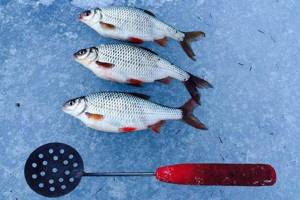
Search and stationary tactics on the first ice
The choice of tactics for catching roach in winter on the first ice depends on the conditions of the area and the reservoir where fishing is to be done. On huge areas of lakes and reservoirs like Ladoga or Tsimla, finding feeding fish at random can be problematic. You need to find out the approximate water areas in which they catch from year to year, and go there. This could be a specific bay or water area near a populated area. Therefore, it is better to make inquiries on fishing forums or with locals.
- On medium and small bodies of water, where the other shore is at least visible, it is easier to search. If there is no information, we use search tactics, checking roach depths from shore to bed, from 1.5 to 5 meters. If there is accurate information, for example, that in such and such a bay the roach takes bait in the evening or at night, we feed and fish stationary.
- The standard search tactic for roach is to drill and feed 10-15 holes at a distance of at least 10 meters from each other. Then we check one by one with fishing rods for riser or with jigs for play. You can’t drill often and feed them - in this case, the fisherman will not collect fish, but rather will scatter them between nearby holes.
- For roach we drill sparsely, 10 meters, or better yet 15-20 between points. If a working place is found, you can carefully drill a couple more holes nearby for several fishing rods. At the same time, do not forget to visit old spots, especially if the bite on the main one disappears. The roach often moves to another place. The first ice is not thick, and drilling many holes at this time is not problematic.
- Usually, the search method when catching sorog on the first ice is always ahead of sitting on bait in terms of catchability. The roach is not tied to a specific point. She wanders around a certain water area like a pirate. The fisherman’s task is to find the place where the roach in this area of the reservoir is located right now. Then you need to interest the fish, hold it so that the school does not leave. For this, bait is used.
- It is recommended to sit on bait only in cases where it is known for certain that there are roaches at this particular point and it reacts well to this mixture. In other cases, it is better to start with an active search for fish, especially in the first ice. At the same time, you don’t have to feed the reconnaissance holes along the first ice, or throw in a little bloodworm just to provoke the fish.
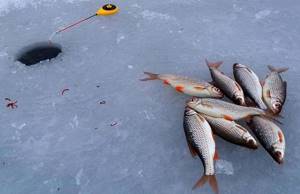
Lure
As already mentioned, bait for roach on the first ice is only needed to keep the fish near the hole. The sorog is now actively feeding, and the angler’s goal is to arouse the fish’s interest in the area of the reservoir under the hole. This aspect also forms the requirements for complementary feeding:
- You cannot feed many holes in a small area (with the exception of two or three holes directly at the point for several fishing rods, under which a single feeding area is formed). You cannot feed holes located 3-5 meters or closer. Then the fish will scatter among them.
- The fisherman’s task is to gather the school in one feeding area. Therefore, we drill exploration holes in increments of 10-20 meters, not closer. From such a distance, the roach will notice the boiling water and will visit the area to check whether it is possible to grab something there.
- The roach needs to be fed often, but little by little. If you pour out the food right away and create a spot on the bottom, this will more likely attract crucian carp, silver bream or white bream.
- Naturally falling particles and turbidity are what roaches like. Therefore, by constantly throwing up a small amount of food, we create a working bait column in which the particles slowly sink throughout the depth in this place.
- Hence the requirements for consistency - you need a loose, light mixture, and not a sticky, lumpy porridge.
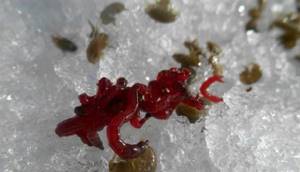
The bait must contain a food element - something that the roach will directly look for and eat in the cloudy cloud. Usually this is a food bloodworm. In some reservoirs, roaches are well attracted to millet.
- For example, the standard mixture in Tsimla for crucian carp and roach from year to year is crumbly washed millet with ground fried seeds (cake).
- In the middle zone, cake does not work, here we feed store-bought winter fine or feeder mixtures with natural odors, or homemade ones based on breadcrumbs, ground biscuits, adding live bloodworms, and on rocky reservoirs - mormysh.
What we put on the hook should also be present in the bait in a less attractive version. It can be bloodworms, maggots, chopped worms, steamed pearl barley or wheat. The main bait, naturally, is bloodworms, however, in some reservoirs, roaches normally take maggots, udders, or even plant baits.
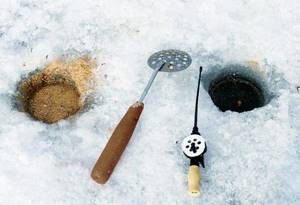
You need to experiment with the composition of the bait - in the regions, roach reacts to the components differently. Here are some ingredients that work on roaches in different areas:
- Unrefined oils – dill, sunflower, anise.
- Ground grains and seeds - the same sunflower, peanuts, pumpkin.
- Sweet additives - honey, vanilla, halva.
- Vitamins – Revit, Gendevit, Undevit and the like.
- Any ground grains - semolina, peas, corn.
- Additives for turbidity - sand, clay, milk powder.
- Natural additives - live bloodworms, chopped worms, maggots.
There is no single best recipe for feeding roach - you need to select it experimentally, depending on the reservoir. In advance, on an unfamiliar body of water, it is difficult to say what the ice pick will bite better on the first ice. We work carefully with aromatics and non-traditional ingredients. It is better to rely on an active search and small portions of live bloodworms or mormysh into the hole.
Read more in the article about proper winter bait for roaches:
https://podlednik.ru/nazhivki-i-podkormki/prikormka-dlya-plotvy-zimoj
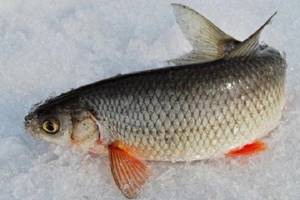
Baits and lures
In addition to artificial baits, which are an addition to mothless baits, artificial bloodworms and maggots are sometimes used instead of natural ones. With a good bite this is justified.
The following natural baits are used for catching roach:
- bloodworm;
- maggot;
- worm;
- burdock moth larva;
- dough;
- lard or meat.
In different bodies of water, roach have different attitudes towards the type of bait. Even bloodworms cannot be considered a universal bait if the roach prefers dough.
Expert opinion
Knipovich Nikolai Mikhailovich
Zoologist, hydrobiologist. I am interested in fishing at a professional level.
For stationary fishing, when you want the bait to stay on the hook for as long as possible, it is better to use maggots or lard. Interestingly, in summer the roach completely ignores lard.
How to catch roach on the first ice
So, the first thing we do when fishing for roach on the first ice is to drill 10-15 holes and, perhaps, feed each one a little. Next, we take turns fishing using the method in which we most often catch – with a jig, a reelless bait, or stationary fishing rods.
- In the case of bait fishing, you need to try to catch both with the game and with a stationary bait on the bottom or 3-7 cm above it. A roach can take a stand today, and tomorrow - with a moving bait.
- If there are no bites in the bottom zone, we check the middle and top layers, especially if the fishing is done near the grass.
- If at this moment in time there is no active bite, the fish can still be provoked and forced to feed. It is important to find a place and choose an effective fishing technique. A roach may begin to grab the bait not out of a desire to be satisfied, but out of curiosity.
- If you managed to catch 1-2 fish, half the job is done, the fish is found. Roach is a schooling fish; if at least one bites, this is a sure sign that fish are present here.
- The further task is to identify the most working holes and select a working bait, bait delivery, and features of playing with a jig.
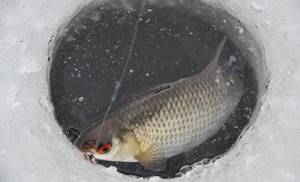
We begin to feed the working hole, throwing in a pinch of bait every 5-7 minutes. In weak currents and depths of more than 3 meters, we deliver bait with a dump truck, pouring it about a meter above the bottom to create a cloud of falling particles. In a strong current, we lower a feeder or a linen bag filled with food higher up in another hole to create a feeding strip.
You need to constantly experiment with rigs, jigs and methods of play - change baits, add hanging hooks to fishing rods on bends, fish by playing or standing until a method that is effective today is found. Therefore, experienced fishermen have several tackles with equipment prepared in their boxes in order to quickly test different options without having to worry about tying them on the pond.
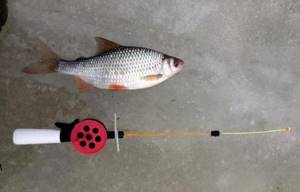
At What Time Are Roaches Most Active?
The most promising time of year for roach fishing is November-December, and March-April. Accordingly, as you already understood, this is for the first and last ice.
3 ways to improve your fish bite!
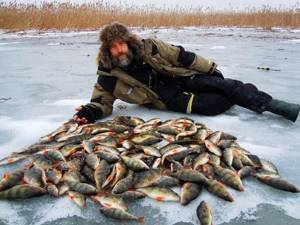
Over 15 years of active fishing, I have found many ways to improve the bite, and here are the most effective:
1. Bite activator . This pheromone additive attracts fish most strongly in cold and warm water. The Fish Hungry bite activator has proven itself to be excellent - Read more…
2. Tackle with increased sensitivity . You should first familiarize yourself with the features of using a particular type.
3. Pheromone baits . They attract the attention of fish, stimulate hunger and cause a schooling reflex, which allows you to collect a lot of fish in one place.
You can get the rest of the secrets of successful fishing for free by reading my other materials on the site.
3 ways to improve your fish bite!
Over 15 years of active fishing, I have found many ways to improve the bite, and here are the most effective:
1. Bite activator . This pheromone additive attracts fish most strongly in cold and warm water. The Fish Hungry bite activator has proven itself to be excellent - Read more…
2. Tackle with increased sensitivity . You should first familiarize yourself with the features of using a particular type.
3. Pheromone baits . They attract the attention of fish, stimulate hunger and cause a schooling reflex, which allows you to collect a lot of fish in one place.
You can get the rest of the secrets of successful fishing for free by reading my other materials on the site.
At this time, roach can be easily caught using almost any method: a jig with or without a nozzle. But in the middle of nowhere, it’s best to stand still. Moreover, the use of bait is mandatory.
As for the time of day, everything is ambiguous here. Catching roach in winter can be successful both during the day and at night. There are, of course, declines in the bite, but this is not always and not everywhere, it all depends on the place and the method of fishing. Of course, a sudden change in weather can also have an impact, we’ll talk about that later.
Attachment jig
A jig is perhaps the most common method of ice fishing for silverfish. Catching roach on the first ice with a jig is universal, which is an important factor in the success of fishing for this particular fish. The same tackle can be used to fish with a game, a standing position, or even without a bait. Accordingly, the fishing rod is thought out in advance and configured correctly.
The jigs on the first ice for roach are the same as in other periods of winter. First of all, these are ordinary droplets, ovits, and bugs of three basic colors - black, golden or red (copper).
For roach, you don’t need to look for some super-catchy jig from all the variety, but rely on a long-proven basis, focusing on the selection of tactical and technical actions. In a baited jig, the fish are primarily attracted to the bloodworm on the hook.
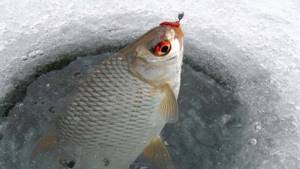
However, roach has excellent eyesight, and the color and shape of the jig sometimes makes a difference. On the first ice, the fish are active, and sometimes bright provoking baits work better than the classics - colored jigs or reelless baits with artificial irritants on the hook. For a good bite, we can experiment, but for passive fish we rely on small, inconspicuous baits, attracting the fish primarily with the bait on the hook.
Article about the right jigs for roach:
The standard set of a roach hunter is the usual small and medium-sized balls, bugs, drops, larvae, ants and small toads of basic colors. Experienced fishermen immediately equip several fishing rods with the most effective jigs in their experience, for example, black and white, in order to quickly check at the beginning of fishing which takes better.
There is only one trend - the worse the bite, the smaller, lighter, neater and more inconspicuous the equipment needed. The capricious roach is careful; in a passive state, it will not take on a thick fishing line, and will immediately spit out a heavy jig.
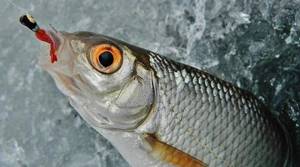
Fishing rod and main line
A fishing rod with a nod and a jig are a single finely tuned system in which the weight of the bait, the elasticity of the nod and the diameter of the fishing line are mutually adjusted. A light jig will not straighten a thick line into an even line. A bait with a soft nod that is too heavy is spat out by the fish during periods of passivity, since the overly flexible guard does not take part of the weight upon itself when rising.
The choice of fishing rod is not so important - as long as it is convenient for the angler. For a beginner winter skier, any balalaika, non-seed or filly will be suitable. For your first fishing trips, a standard store-bought fishing rod with a cork or foam handle will do. Experienced jig fishermen use lightweight foam balalaikas or small sports fishing rods.
The whip on such a fishing rod is made of vinyl, polycarbonate or other plastic material that is flexible and does not break when bent in severe frost. Each angler eventually comes to his own vision of the most convenient winter fishing rod. More information about fishing rods for winter jigs:
https://podlednik.ru/snasti/mormyshki/zimnyaya-udochka-dlya-mormyshki
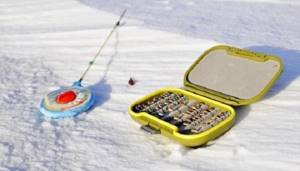
Some anglers prefer to fish constantly with an active jig, others prefer to fish with fishing rods. The third group are generalists who fish by any means - depending on what they catch better. For roaches, universalism is very useful. At one time this fish reacts better to standing position, at another time to active play, including on the first ice. Therefore, on every fishing trip you need to check both options.
A fishing rod for roach in winter should be adapted both for installation on ice and for active play. Therefore, a nodding rig with a game guard finely tuned to the weight of the jig is more appropriate here. However, if the fish takes a stand, nothing prevents you from putting the legs on the whip and placing the tackle on the bottom motionless. At the same time, nothing prevents float lovers from having a couple of tuned float rods in reserve in the box.
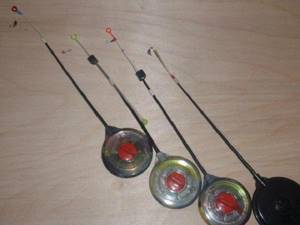
I usually have a universal set in my drawer - sporting balalaika fishing rods of various calibers, from 0.08 mm fishing line and 0.1 gram jigs to 0.2 mm base with gram or more baits (for carp, bream or large crucian carp). There are also tackles with thin line and heavy jigs - for fishing in currents or great depths.
Each nod is carefully tuned to a specific bait. Jigs are mostly standard droplets, balls, larvae of basic shapes, colors and configurations (more than half are black). For roach, the lightest of these tackles are used - fishing lines 0.08, 0.1 and 0.12 mm, with jigs up to 0.5 grams, but more often - 0.1-0.3 grams.
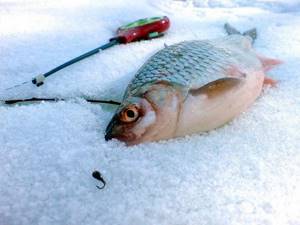
- A short lead (3-4 cm) 5-7 cm above the main jig with a small hook on which 1-2 bloodworms are attached often works well for roach. The silver weasel often grabs such a pendant both when playing and when standing from the bottom. Such a bait sinks slowly and naturally after the jig stops, which attracts roaches.
- More often it is the nod that is used, not the float. Firstly, this allows you to fish by passively setting on the bottom and playing with the same gear.
- Secondly, it is convenient when searching combined with standing fishing, when you need several fishing rods to be simultaneously installed at a distance of 1-3 meters from each other, followed by moving one to a new place every 15-30 minutes. In this case, the nods are visible on all fishing rods from one observation point, but the floats would not be visible, because they are recessed into the water of the hole by 2-3 cm.
- For passive roach we use the thinnest gear - with fishing lines up to 0.08 mm and light jigs. This requires a good quality thin winter monofilament fishing line. Then you can safely catch fish under a kilogram.
Article about the right winter fishing rods for roach:
https://podlednik.ru/lovlya_zimoj/na-udochku/osnastka-zimnej-udochki-na-plotvu
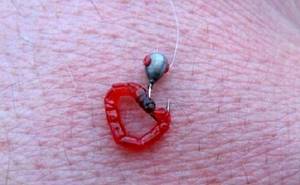
Setting the nod
Previously, nods were made independently from boar bristles. Nowadays synthetic materials are in use. The most common option is lavsan and x-ray film. Cheap lavsan gatehouses can be found in any store or made with your own hands. The nod is selected according to the weight of the jig, so you need to buy them according to the test. Normal manufacturers indicate the test on their products.
Some enthusiasts use nods made from clock springs, carbon fiber and other materials, but such alarms are more difficult to manufacture. I never reinvented the wheel and used ordinary mylar guards - that’s quite enough. The main thing is to choose the right one for the jig.
If the test is not specified, we take a nod of such elasticity that under the weight of the jig in the water it bends a quarter of a circle. The nod can also be sharpened with a blade to a cone in thickness and width, selecting the desired amount of bending.
Detailed article about setting the nod on a winter fishing rod for jigs:
https://podlednik.ru/snasti/mormyshki/kak-podobrat-kivok-pod-mormyshku
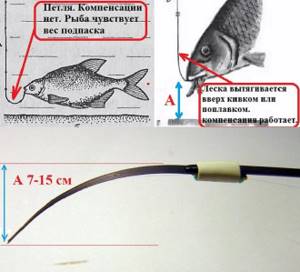
Working with tackle
The presence of properly equipped fishing rods and the location of the roach found even on the first ice does not guarantee a catch. This fish requires creativity and experimentation. As already mentioned, at a minimum, you need to check whether the fish is now taking a fixed bait or a suspension above the main jig. Often bites occur only after a certain combination, some special movements during a pause after the game, or other immediately unobvious provocations. You always need to pick up keys for roaches.
On the first ice, we are still more focused on the game - the roach are now active and feeding relatively steadily. However, even active roach often take better positions when standing. Even on stationary fishing rods there can be several positions from the bottom - and this sometimes significantly affects the bite.
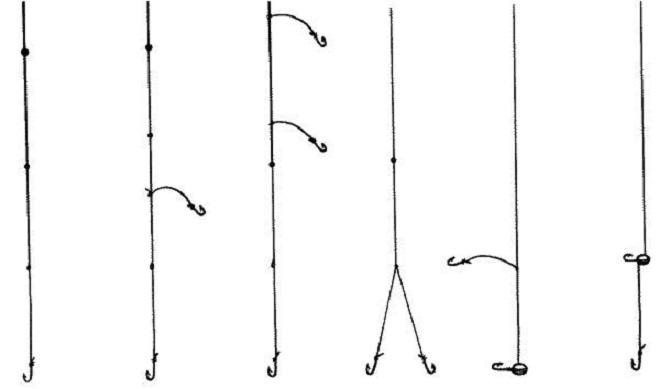
Equipment options
- The jig can simply be placed on the bottom; the nod does not bend completely into the load state, which means that the bait lies completely.
- A suspended state, when the hook with the bloodworm touches the bottom, but the body of the jig hangs in the water. To position the fishing rod this way, when installing the tackle, slowly lower the fishing rod until the nod just begins to rise slightly. We fix the fishing rod in this position with a reel. Every millimeter is important - you can’t position the tackle like that on a rough, untuned nod.
- Position above the bottom, 5-7 millimeters. We also adjust by nod.
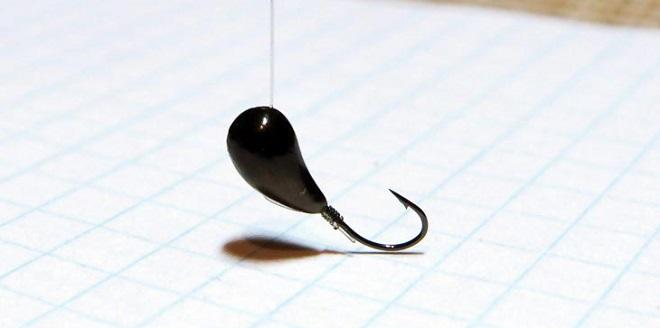
If it doesn’t bite in any way, we provoke the roach with a game.
- The main effective movement for the silver beauty is the natural fall of the bait from a height of 0.7-1 meters. Moreover, it is advisable to do such a fall during the first lowering - a bite can happen immediately. We slowly accompany the sinking jig with our hand, slowing down the planning. At the same time we set the depth on the reel.
- Another working provocation is simply moving the bottom or tapping it, and then pausing. The jig returns to one of the described stationary states. The rise from the ground is no more than 3-5 cm. Classic crucian carp provocation.
- The usual stepwise guiding along the first ice also works. Moreover, testing this method should begin with a downward movement - planning at 30-50 cm, pause.
- We try the usual step up - we make small oscillatory movements, slowly raising the fishing rod. We pause at certain intervals.
- We experiment with the oscillation frequency, amplitude, length of segments before pauses and the delays themselves. A roach on the first ice can simply grab the jig, with many types of movements. However, sometimes she is capricious and reacts only strictly to a certain combination, which needs to be selected.
Article about jig fishing on the first ice: link coming soon
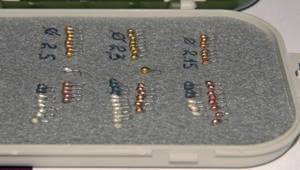
Choosing Jig Weight
The Weight of the Chosen Jig is Affected by Several Factors:
- Depth at the fishing spot;
- The strength of the current;
- Line diameter.
For active jig fishing, heavy weight is not necessary. The optimal weight of the jig should be such that the nod under its weight bends by ¼ of the entire bend. If you decide to fish standing, then the weight of the jig can be increased.
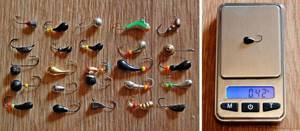
Float rods
With a float fishing rod, it is difficult to perform the manipulations described above - position the jig in different positions on the bottom and above it, as well as play a delicate game. However, for a good bite, such equipment is enough. There are fewer experiments here - we install the equipment on the bottom and periodically tap. You can also hold the fishing rod while lowering the bait, performing a natural fall game.
We equip the float fishing rod with an additional short leash so that the second hook is 5-10 cm above the bottom. A roach bite on a float does not always result in a rise. Often the float dances, moves to the side or walks along the hole. Fishing rods with a float work well in places where roach are not particularly capricious and like to take from the bottom.
Secrets of Successful Roach Catching from Professionals
The Most Useful Tips and Additions from Experienced Anglers:
When fishing with a no-attachment jig, 10-15 centimeters higher up the line, tie a regular hook with a nozzle;
Additionally, they attract fish by tying small antennae made of thread onto a reelless hook;
Many anglers carry a set of colored markers, thereby changing the color of the jig in search of the best response from the roach.
We are coming to the end of our article. If it was useful for you, and you learned something new for yourself, then we didn’t write in vain. An excellent video on the tactics and techniques of catching roach, will brighten up the ending of our material.
Mothless
Recently, catching roach on the first ice using a reelless bait has become popular. At this time, active fish forgive the mistakes of beginners in the game and setting up the tackle. Therefore, the first ice is the best time to practice for beginners without bait. However, if you dig deeper, the reelless jig is a jewelry and catching type of jig. In this kind of fishing, there are more stringent requirements for the nod and the choice of jig. In experienced hands, a baitless bait copes with roach no worse than a classic, and sometimes the trophies are even larger. Read more about rewinding on the first ice.
The main thing in baitless fishing, including for roach, is to get your hand on the jig’s retrieve. And what is important here is not the high frequency of vibrations, as some beginners think, but stability, the same amplitude of movements. All changes are made thoughtfully, specifically, as provocations. When using a nozzle, you also need to think about the correct grip so that your hand does not get tired.
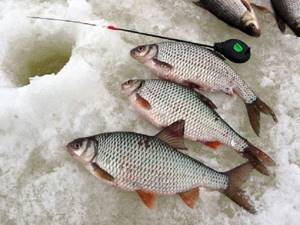
Changing the position of the hand and grip also changes the characteristics of the game of the bait. In such gear, in addition to the nod and equipment, the characteristics and convenience of the fishing rod itself are important. All experiments come down to selecting bait and finding a working game.
When fishing with a reelless bait, bait is often not used (sometimes as a matter of principle). But in general terms, the search tactics described in the article work. In the first ice, a wide range of baitless baits work for roach on various reservoirs - nymphs, standard jigs with pendants, bananas, devils, goats and others. The fisherman’s task is to find a working one and match it with a game. Read more about equipment, baits and methods of placing them in a detailed article about reeling for roach:
https://podlednik.ru/lovlya_zimoj/na-mormyshku/bezmotylka-na-plotvu

Winter fishing tactics and techniques
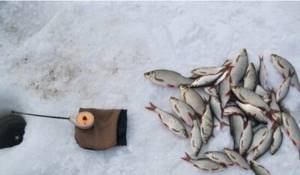
The first ice is a time of increased activity of fish in winter, including roach, so an angler who wants to master this interesting and productive method of fishing should learn to fish with a reelless reel at this time.
On the current
The tactic for catching roach in the current is to look for places where the current is not too strong
, for example, areas with a “return”, backwaters, etc. It is useful to install a stationary feeder upstream - the smell of food will in any case interest the roach. In the current, you have to use heavier jigs and thicker fishing lines, although the latter have more sail.
In still water
In stagnant bodies of water, roaches are searched for either by combing the water area, or by feeding the holes and then returning to them.
If you are fishing for schooling roach, you need to carefully monitor the behavior of other anglers.
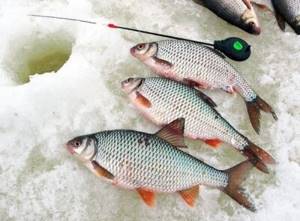
The technique for catching roach using a reel is as follows:
- The jig is lowered to the bottom, making short stops and twitches.
- Tap the jig on the bottom several times.
- Raise the jig a few centimeters, performing fairly high-frequency but low-amplitude vibrations.
- They pause.
- Raise the jig another distance.
- Continue the cycle.
- During subsequent lowering, similar movements are performed.
Roach, like perch, can stay in half-water, so you shouldn’t limit yourself to bottom fishing only.
A bite on a reelless fish can be expressed in different ways.
If the nod sharply bends downwards, then there is no room for doubt - the fish has bitten.
The rise of the nod also clearly indicates a bite. But such a fairly common type of bite as a delayed nod can be missed by an inexperienced angler. And this is the moment to hook.
Catching roach with a reelless reel on the first ice is a joyful event for many anglers. The bites are “evil”, the fish fights furiously, the pile on the ice grows - what else does an angler hungry for winter fishing need?
Fishing in strong currents
On large rivers with strong currents, it is impossible to fish comfortably with ordinary light fishing rods with a nod or a float. Other gear is used here - sub-ice donks with a heavy sinker that can hold the equipment in the flow. The basis of search tactics is the same. We lower the bait upstream so that fishing takes place in the washed-out feed trail. Some ice bottoms are equipped with feeders - for example, descenders.
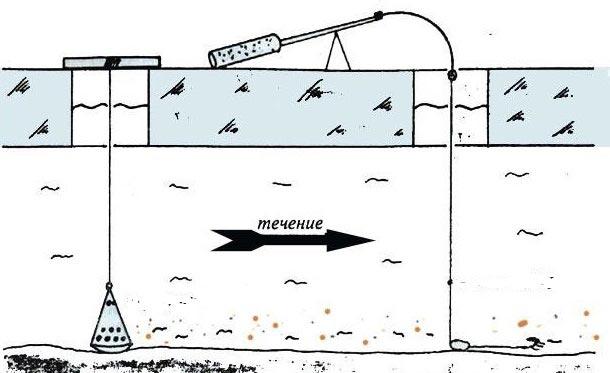
Typically, such methods are used for bream and silver bream. However, along with this fish, roach is often caught, and a large one at that. For targeted roach fishing, you can use weight fishing rods with a nod of the simplest design. The sinker in such a rig is attached to the end of the fishing line, and the hook or jig is attached to the outlet leash. The weight is selected depending on the strength of the current in order to hold the equipment at the desired point.
In the first ice, roach in the current can also be caught with a fishing rod according to the rolling principle, lowering the equipment by a step further in the stream along the bottom. A large area is fished in this way. An article about catching roach from ice in a strong current.
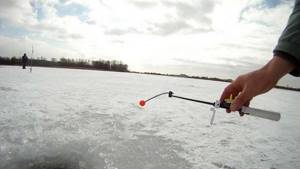
The influence of weather on the Roach bite
It is impossible to say with 100% accuracy, but according to the notes of fishermen, roach is most active at low atmospheric pressure.
In frost and clear, sunny weather, the roach bites worse. Cloudy or cloudy weather is much more favorable for roach fishing. The sudden change in weather did not affect the bite in most cases.
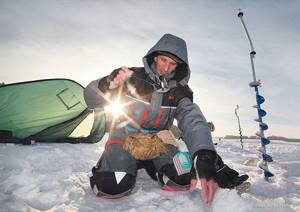
Subtleties and secrets
- Jigs on the first ice for roach can be checked not by traditional ones, but by various unusual and bright ones. Active fish often take such provocateurs on the first ice.
- When fishing for roach on the first ice on lakes, quarries and rivers with clear water at depths of less than 3 meters, you should wear camouflage, especially in sunny weather. The fish perfectly sees the shadow of a moving fisherman in clear water through thin transparent ice. You can throw a raincoat over the clean ice in the stationary fishing area or throw crumbs at it. In cold weather, you can pour water - it will freeze and make the surface less transparent. It is also better to darken the hole with snow or ice chips, making a hole with the handle of a slotted spoon to lower the jig.
- In some reservoirs, roach is better caught at night, including in the first ice. In this case, small jigs with a small phosphorus luminous droplet often work well, which must be periodically recharged from the light of a candle or flashlight.
- In case of a good bite, the working holes need to rest, especially if the roach begins to bite gradually worse. The holes need to be fed and left for at least half an hour. During this time, you can check and feed reserve positions.
- If small crucian carp, bream or crucian carp come up for bait, the roach will most likely rise higher and will try to intercept the sinking food as it approaches the bottom.
- When the weather changes, you need to check all layers of water, middle and even top. Roach can rise higher following the migration of zooplankton.
Subscribe to the channel:
My YouTube channel RYBAFAN on fishing:
We're OK
How to choose a jig for roach by color?
Regarding the color schemes of jigs for roach, there is no clear opinion among fishermen yet. Some argue that color is not particularly important, since no one has yet been able to prove the fact that fish distinguish colors. Other anglers are inclined to believe that color matters.
According to other anglers, the most catchy jigs for roach are those that have metallic colors - bronze, silver, copper, gold, red, gray and black. Among other things, all sorts of shades of these colors work great. Some anglers are great at catching winter roach using very unusual colors - green or purple. Most likely, you need to focus on the preferences of the roach in each individual body of water.
Read with this
- How to choose the best jigs for roach while fishing{q}
- Effective summer bait for roaches
- How to equip a winter fishing rod for roach fishing
- How to make a jig with your own hands
- We tie the jig to the fishing line on a winter fishing rod
- Rating of the best fishing rods for winter fishing: the most convenient new products for ice fishing
- Reelless jigs
- Catching pike perch with live bait
- Catching perch on the first ice with a jig
- Fishing for devil in winter
